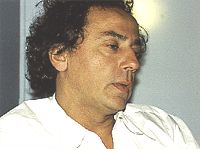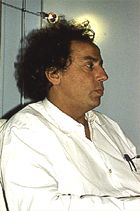|
| netribution > features > interview with darius khondji > page two |
 |
| |
| | | | | | | |  Do you have a particular camera and stock that you regularly use?
No. Its very important to me that you read a story as new every time, it helps that I have a bad memory and I keep the best of my memory for the director. When I meet the director for the first time I try to listen is deeply and emotionally and as intensely as I can and technique, camera, lenses and stock come way after. If they know a little about my techniques, then I try to share as much with them as possible, I like the director to be responsible for the look of the film. The look must be very close to the director's soul, probably something you've heard before from me! I can only say things that I really mean and they can sometimes be repetitive so I'm sorry about that!
Was your interest in horror what attracted you to Se7en, or was it more David Fincher?
More David Fincher. My interest in a movie comes mainly from the director's personality, from what he tells me. Whether I find common ground with the director is what determines whether I should work with them or not.
Were you the first to use the Silver Retention Process?
No it had been used way before me, I've never invented anything. Roger Deakins, the great cinematographer used it for 1984 and Vittorio Storaro created it in Rome. I used it in one of my early shorts called The Treasure of the Beach Islands, we shot it in 1989 in black and white negative. That was the first ever feature printed on sound stock and I think La Haine did it years later too. That led me to a process that increases the sharpness and the contrast and it makes the actors almost larger than they are. I remember Orson Welles saying that black and white is like a magnifying glass over the actors and I really thought about that because even in colour you can create the effects of black and white in contrast. That's why I use that process on different films and on different levels but its not called silver retention anymore, its called bleach bypass or CCE in Los Angeles. Technicolor call it E & R but that's a different version of the process but it’s the one I like the best.
Do you use source generated lighting in all your films?
I love the idea that all the light is generated by a source within the film because it always plays a part in the story you are telling, The light itself is alive. Its coming from some one and I think that a light that is coming from nowhere is a very scary thing, it needs to be kept to science fiction films or for a specific conceptual light for a story. In Alien Resurrection, Sigourney Weaver is made to look like she is lit by the ambience and not from the spaceship, she is lit by herself. 
Which artists and photographers do you draw inspiration from?
From various paintings. Those of the Norwegian painter, Edvard Munch, Andrew White the American realist painter, George Bellows. Also an illustrator called Martin Lewis and Robert Keenan the modern realist painter. It depends on the story but I don't like the idea of having literal influences directly from a painting, I like the idea that an image on film haunts you and you leave with it. I understand that there is a link between painters and photographers to cinema. I carry a book called, The Americans by Robert Frank, I carry it with me like a friend. You also use influences that come from your life. Like this moment, by seeing you with evenly lit walls behind you, everything's a cool, pale blue but you are in the shade. Then you work with the shade and it becomes an interesting image but you have to work to make it interesting.
The influences have been various but I don't like them to be direct from another piece of work, it needs to come from a past moment that lives with you and then comes out at the right moment for the film.
What was it like working with Danny Boyle
Great. It was one of the best experiences I've ever had with a director. He's very inspirational and very open and adventurous. And he's a very nice person, its rare to have all of those together.
Have you any idea why it didn't do well at the box office?
Well I'm a bit bitter about it. Not bitter, sad because I really like it, there were good collaborations on it, like our work with Leonardo Di Caprio. The teamwork between director, producer and the main star was so complete and so perfect. Danny had prepared very well too, he had a complete book of image references and we would refer to these throughout, even during a shot. I'm sad because it was such a great experience, the producer was so much in tune with the director and the actors. For me, the work was very interesting and I would have loved the film to be a huge success.
What are you working on now?
On a very exciting film called, Panic Room with David Fincher. We shoot in October.
Will it be on similar lines to Se7en?
No, very different. I can't think of a reference but it is immediately exciting for me because it is David Fincher. The way he presents the script and tells you want he wants done with it, very exciting.
Do you think you'll ever use digital?
I love digital. It allows artists to do great things and I would like to be asked to do a project with it but the important thing is the person.
Might we see a Darius Khondji Dogma film?
I'd love to do a Dogma film. I find it very interesting personally, not only for what it is but I love that it exists in itself.
Darius Khondji - Filmography
Delicatessen (1991)
The City of Lost Children (1995)
Se7ven (1995)
Stealing Beauty (1996)
Evita (1997)
Alien Resurrection (1997)
In Dreams (1998)
The Ninth Gate (1999)
The Beach (2000) | | | | |  |  |  |  |  |
|
 |